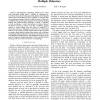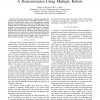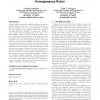7 search results - page 1 / 2 » How robot morphology and training order affect the learning ... |
CEC
2009
IEEE
13 years 11 months ago
2009
IEEE
— Automatically synthesizing behaviors for robots with articulated bodies poses a number of challenges beyond those encountered when generating behaviors for simpler agents. One ...
ICRA
2006
IEEE
13 years 10 months ago
2006
IEEE
— This paper demonstrates a learning mechanism for complex tasks. Such tasks may be inherently expensive to learn in terms of training time and/or cost of obtaining each training...
GECCO
2009
Springer
13 years 11 months ago
2009
Springer
A central tenet of embodied artificial intelligence is that intelligent behavior arises out of the coupled dynamics between an agent’s body, brain and environment. It follows t...
AR
2007
13 years 4 months ago
2007
Joint attention is one of the most important cognitive functions for the emergence of communication not only between humans but also between humans and robots. In the previous wor...
AAAI
2007
13 years 7 months ago
2007
We present black-box techniques for learning how to interleave the execution of multiple heuristics in order to improve average-case performance. In our model, a user is given a s...



